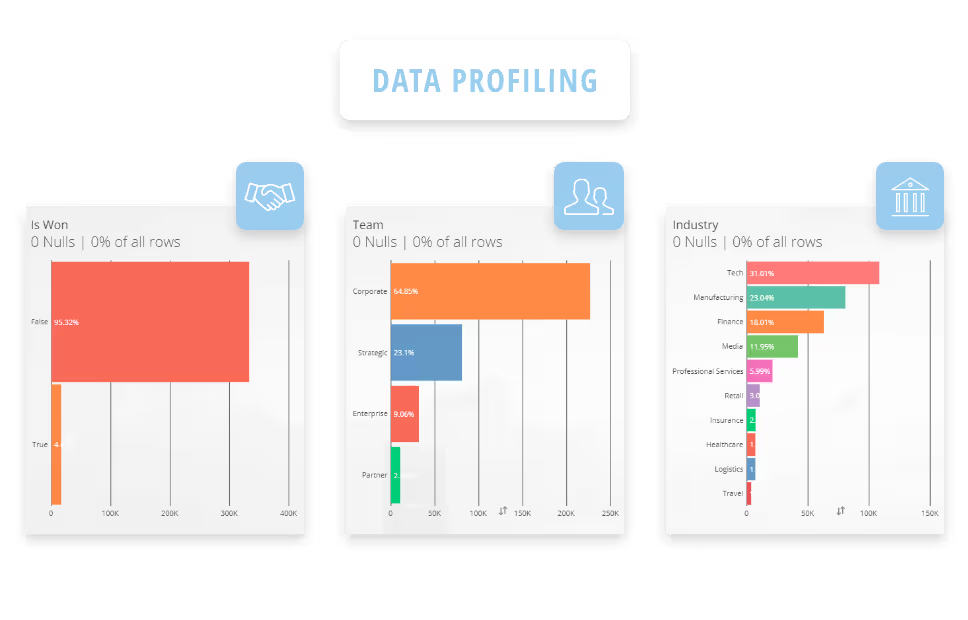
Saved 100s of hours of manual processes when predicting game viewership when using Domo’s automated dataflow engine.

The goal of machine learning is to train machines to get better at tasks without explicit programming. To achieve this goal, several steps have to take place. First, data needs to be collected and prepared. Then, a training model, or algorithm, needs to be selected. After which, the model needs to be evaluated so that hyperparameter tuning can happen and predictions can be made. It’s also important to note that there are different types of machine learning which include supervised learning, unsupervised learning, semi-supervised learning, and reinforcement learning.
Machine learning, a dynamic branch of artificial intelligence, empowers systems to enhance their performance over time without the need for explicit programming. Its defining features include:
Machine learning is when both data and output are run on a computer to create a program that can then be used in traditional programming. And traditional programming is when data and a program are run on a computer to produce an output. Whereas traditional programming is a more manual process, machine learning is more automated. As a result, machine learning helps to increase the value of embedded analytics, speeds up user insights, and reduces decision bias.
While machine learning is a subset of artificial intelligence, it has its differences. For instance, machine learning trains machines to improve at tasks without explicit programming, while artificial intelligence works to enable machines to think and make decisions just as a human would.
Deep learning is a subset of machine learning, and it uses multi-layered or neural networks for machine learning. Deep learning is well-known for its applications in image and speech recognition as it works to see complex patterns in large amounts of data.
There are three main elements to every machine learning algorithm, and they include:

Machine learning helps software applications become even more accurate at predicting outcomes without being explicitly programmed. More and more industries are employing machine learning in the following ways:
Machine learning can be categorized into three main types, each tailored to specific applications:
When it comes to the different types of machine learning, supervised learning and unsupervised learning play key roles. While supervised learning uses a set of input variables to predict the value of an output variable, unsupervised learning discovers patterns within data to better understand and identify like groups within a given dataset.
Supervised learning is the most common type of machine learning and is used by most machine learning algorithms. This type of learning, also known as inductive learning, includes regression and classification. Regression is when the variable to predict is numerical, whereas classification is when the variable to predict is categorical. For example, regression would use age to predict income, while classification would use age to predicate a category like making a specific purchase.
Within supervised learning, various algorithms are used, including:
Unsupervised learning is useful when it comes to identifying structure in data. There are many situations when it can be near impossible to identify trends in data, and unsupervised learning is able to provide patterns in data which helps to inform better insights. The common type of algorithm used in unsupervised learning is K-Means or clustering.

With machine learning, you want to understand the basics, and you also want to be aware of the algorithms that underpin machine learning. To get started, you want to:
Domo has created a Machine Learning playbook that anyone can use to properly prepare data, run a model in a ready-made environment, and visualize it back in Domo to simplify and streamline this process. Since building and choosing a model can be time-consuming, there is also automated machine learning (AutoML) to consider. AutoML helps to pre-process data, choose a model, and hyperparameter tune.
Domo’s ETL tools, which are built into the solution, help integrate, clean, and transform data–one of the most challenging parts of the data-to-analyzation process.
Machine learning helps businesses reach their desired outcomes faster. Machine learning can help businesses improve efficiencies and operations, do preventative maintenance, adapt to changing market conditions, and leverage consumer data to increase sales and improve retention. Machine learning is even being used across different industries ranging from agriculture to medical research. And when combined with artificial intelligence, machine learning can provide insights that can propel a company forward.

There are countless opportunities for machine learning to grow and evolve with time. Improvements in unsupervised learning algorithms will most likely be seen contributing to more accurate analysis, which will inform better insights. Since machine learning currently helps companies understand consumers’ preferences, more marketing teams are beginning to adopt artificial intelligence and machine learning to continue to improve their personalization strategies. Additionally, machine learning and deep learning are going to evolve. For instance, with the continual advancements in natural language processing (NLP), search systems can now understand different kinds of searches and provide more accurate answers. All in all, machine learning is only going to get better with time, helping to support growth and increase business outcomes.
Machine learning is transforming industries by boosting efficiency, enhancing decision-making, and driving innovation. Here are some of its most impactful applications:
Machine learning continues to reshape how we work, live, and innovate, unlocking new possibilities across countless sectors.
Machine learning models refine their predictions and accuracy by continuously learning from new data. The key mechanisms for improvement include:
Additionally, advancements in model architectures, such as transformers and neural networks, enable more efficient learning and better handling of complex data. Improved computational power and scalable infrastructure also play a critical role in speeding up the training and optimization processes for machine learning models.
